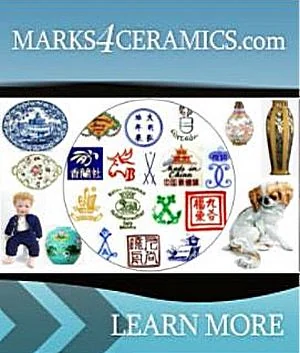Pricing Guides & Dictionary of Makers Marks for Antiques & Collectibles

A few examples of appraisal values for
1906 B
Search our price guide for your own treasures
-
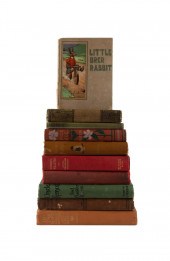 10VOL J.CHANDLER HARRIS BOOKS,
10VOL J.CHANDLER HARRIS BOOKS, INCLUDING 1ST ED. A lot of 10 books by Joel Chandler Harris, including first editions. Tales of the Home Folks in Peace and War by Joel Chandler Harris. Published 1898 by Houghton Mifflin. First edition. Red cloth boards with gilt and black decoration. 8vo. 417pp. The Story of Aaron by Joel Chandler Harris. Published 1896 by Houghton Mifflin. First edition. Tan pictorial boards with gilt titling. 8vo. 198pp. Little Mr. Thimblefinger Stories by Joel Chandler Harris. Published 1894 by Houghton Mifflin. Riverside Literature Series edition. Green cloth boards with black titling. 12mo. 164pp. Little Brer Rabbit by Joel Chandler Harris. Published 1907 by Berger Publishing. Pictorial cardboad boards with titling in yellow and blue. 12mo. Uncle Remus, or Mr. Fox, Mr. Rabbit, and Mr. Terrapin by Joel Chandler Harris. Published 1921 by Chatto and Windus. Eighth impression. Green boards with a color scene on the front. 8vo. 288pp. Free Joe and Other Georgian Sketches by Joel Chandler Harris. Published 1906 by Scribners. Red boards with polychrome illustrations on the front. 8vo. 236pp. On The Plantation by Joel Chandler Harris. Published 1892 by D. Appleton and Company. First edition. Tan cloth boards with rabbit illustration on the front. 8vo. 233pp. Mingo and Other Sketches by Joel Chandler Harris. Published 1884 by James Osgood. Green boards with gilt titling and black floral decoration. 8vo. 273pp. Gabriel Tolliver by Joel Chandler Harris. Published 1902 by McClure. Red cloth boards with gilt titling and blind stamping. 8vo. 448pp. The Tar-Baby and Other Rhymes of Uncle Remus by Joel Chandler Harris. Published 1904 by D. Appleton and Co. Peach colored boards with gilt titling and decoration the front cover. 8vo. 189pp.
10VOL J.CHANDLER HARRIS BOOKS,
10VOL J.CHANDLER HARRIS BOOKS, INCLUDING 1ST ED. A lot of 10 books by Joel Chandler Harris, including first editions. Tales of the Home Folks in Peace and War by Joel Chandler Harris. Published 1898 by Houghton Mifflin. First edition. Red cloth boards with gilt and black decoration. 8vo. 417pp. The Story of Aaron by Joel Chandler Harris. Published 1896 by Houghton Mifflin. First edition. Tan pictorial boards with gilt titling. 8vo. 198pp. Little Mr. Thimblefinger Stories by Joel Chandler Harris. Published 1894 by Houghton Mifflin. Riverside Literature Series edition. Green cloth boards with black titling. 12mo. 164pp. Little Brer Rabbit by Joel Chandler Harris. Published 1907 by Berger Publishing. Pictorial cardboad boards with titling in yellow and blue. 12mo. Uncle Remus, or Mr. Fox, Mr. Rabbit, and Mr. Terrapin by Joel Chandler Harris. Published 1921 by Chatto and Windus. Eighth impression. Green boards with a color scene on the front. 8vo. 288pp. Free Joe and Other Georgian Sketches by Joel Chandler Harris. Published 1906 by Scribners. Red boards with polychrome illustrations on the front. 8vo. 236pp. On The Plantation by Joel Chandler Harris. Published 1892 by D. Appleton and Company. First edition. Tan cloth boards with rabbit illustration on the front. 8vo. 233pp. Mingo and Other Sketches by Joel Chandler Harris. Published 1884 by James Osgood. Green boards with gilt titling and black floral decoration. 8vo. 273pp. Gabriel Tolliver by Joel Chandler Harris. Published 1902 by McClure. Red cloth boards with gilt titling and blind stamping. 8vo. 448pp. The Tar-Baby and Other Rhymes of Uncle Remus by Joel Chandler Harris. Published 1904 by D. Appleton and Co. Peach colored boards with gilt titling and decoration the front cover. 8vo. 189pp. -
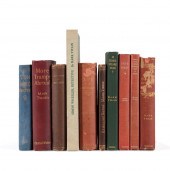 10VOL MARK TWAIN BOOKS WITH SOME
10VOL MARK TWAIN BOOKS WITH SOME 1ST EDITIONS A lot of 10 Mark Twain books with some first editions. Tom Sawyer by Mark Twain. Published 1876 by Belford Brothers. First Canadian edition. Bound in blue cloth with gilt titling and decoration. Wear to boards with some moisture damage evident. Hinges cracked. Some staining on pages. 12mo. 341pp. More Tramps Abroad by Mark Twain. Published 1897 by Chatto and Windus. First English edition. Bound in red boards with gilt titling. Wear to boards with some chipping and scuffing. Pages have some pencil marks and staining in places. 8mo. 486pp. Sketches by Mark Twain. Published 1880 by Belfords, Toronto. Bound in dark red cloth boards with gilt titling on the spine. Some wear to boards with scuffing and chipping. Pages have some light marking. 12mo. 319pp. Simon Wheeler, Detective by Mark Twain. Published 1963 by The New York Public Library. Edition limited to 1500 copies. Bound in quarter linen with black titling on the spine. Light wear on the boards and light pencil marks on the end papers. 4to. 204pp. Life on the Mississippi by Mark Twain. Published 1883 by Dawson Brothers, Montreal. First Canadian edition. Bound in red boards with gilt titling on the spine. Wear to boards with some staining on the front. Cracked hinges. Light wear to pages with some pencil marks present. 8vo. 547pp. Rambling Notes of an Idle Excursion by Mark Twain. Published 1878 by Rose-Belford, Toronto. Bound in brown boards with black titling on the front and gilt titling on the spine. Some moisture damage to front boards. Pages have some pencil marks. Hinges are cracking. Bookplate of a previous owner present. 12mo. 150pp. Is Shakespeare Dead? by Mark Twain. Published 1909 by Harper and Brothers. First edition. Some pages untrimmed. Bound in green cloth with gilt titling on the spine. Some wear to boards. Pencil marks from a previous owner present. Bookplates present. 8vo. 149pp. Eve's Diary by Mark Twain. Published 1906 by Harper and Brothers. First edition. Bound in red cloth with pictorial cover. Titling in white. Some wear to boards. Pencil marks present on end papers. 8vo. 109pp. Captain Stormfield's Visit to Heaven by Mark Twain. Published 1909 by Harper and Brothers. Bound in red cloth with a pictorial cover. Some light wear to boards. Pencil marks on end papers. 8vo. 121pp. A Double Barrelled Detective Story by Mark Twain. Published 1902 by Harper and Brothers. Bound in red cloth with gilt titling and decoration. Some wear on the boards with some cloth loss on the spine and back boards. Hinges may have started cracking. Pencil marks on end papers. 8vo. 172pp.
10VOL MARK TWAIN BOOKS WITH SOME
10VOL MARK TWAIN BOOKS WITH SOME 1ST EDITIONS A lot of 10 Mark Twain books with some first editions. Tom Sawyer by Mark Twain. Published 1876 by Belford Brothers. First Canadian edition. Bound in blue cloth with gilt titling and decoration. Wear to boards with some moisture damage evident. Hinges cracked. Some staining on pages. 12mo. 341pp. More Tramps Abroad by Mark Twain. Published 1897 by Chatto and Windus. First English edition. Bound in red boards with gilt titling. Wear to boards with some chipping and scuffing. Pages have some pencil marks and staining in places. 8mo. 486pp. Sketches by Mark Twain. Published 1880 by Belfords, Toronto. Bound in dark red cloth boards with gilt titling on the spine. Some wear to boards with scuffing and chipping. Pages have some light marking. 12mo. 319pp. Simon Wheeler, Detective by Mark Twain. Published 1963 by The New York Public Library. Edition limited to 1500 copies. Bound in quarter linen with black titling on the spine. Light wear on the boards and light pencil marks on the end papers. 4to. 204pp. Life on the Mississippi by Mark Twain. Published 1883 by Dawson Brothers, Montreal. First Canadian edition. Bound in red boards with gilt titling on the spine. Wear to boards with some staining on the front. Cracked hinges. Light wear to pages with some pencil marks present. 8vo. 547pp. Rambling Notes of an Idle Excursion by Mark Twain. Published 1878 by Rose-Belford, Toronto. Bound in brown boards with black titling on the front and gilt titling on the spine. Some moisture damage to front boards. Pages have some pencil marks. Hinges are cracking. Bookplate of a previous owner present. 12mo. 150pp. Is Shakespeare Dead? by Mark Twain. Published 1909 by Harper and Brothers. First edition. Some pages untrimmed. Bound in green cloth with gilt titling on the spine. Some wear to boards. Pencil marks from a previous owner present. Bookplates present. 8vo. 149pp. Eve's Diary by Mark Twain. Published 1906 by Harper and Brothers. First edition. Bound in red cloth with pictorial cover. Titling in white. Some wear to boards. Pencil marks present on end papers. 8vo. 109pp. Captain Stormfield's Visit to Heaven by Mark Twain. Published 1909 by Harper and Brothers. Bound in red cloth with a pictorial cover. Some light wear to boards. Pencil marks on end papers. 8vo. 121pp. A Double Barrelled Detective Story by Mark Twain. Published 1902 by Harper and Brothers. Bound in red cloth with gilt titling and decoration. Some wear on the boards with some cloth loss on the spine and back boards. Hinges may have started cracking. Pencil marks on end papers. 8vo. 172pp. -
 CANDY BOXES WITH MAXFIELD PARRISH
CANDY BOXES WITH MAXFIELD PARRISH ILLUSTRATION C. 19201. The elaborate circa 1920 candy box for Crane Candy Company is decorated in applied gesso in gold finish with central illustration titled The Garden of Allah with copyright lower right and date of 1918.2. A box of unconfirmed origin having a Maxfield Parrish design from 1906 built up in gesso on a mahogany cigar box with block feet added.Measure 3.25 x 11 x 6.5 and 3 x 12.25 x 6 inches.Very good condition. There are no chips, cracks, repairs, scratches or areas of heavy wear.
CANDY BOXES WITH MAXFIELD PARRISH
CANDY BOXES WITH MAXFIELD PARRISH ILLUSTRATION C. 19201. The elaborate circa 1920 candy box for Crane Candy Company is decorated in applied gesso in gold finish with central illustration titled The Garden of Allah with copyright lower right and date of 1918.2. A box of unconfirmed origin having a Maxfield Parrish design from 1906 built up in gesso on a mahogany cigar box with block feet added.Measure 3.25 x 11 x 6.5 and 3 x 12.25 x 6 inches.Very good condition. There are no chips, cracks, repairs, scratches or areas of heavy wear. -
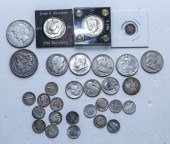 COOL SILVER COIN COLLECTION -
COOL SILVER COIN COLLECTION - BLUE CHANGE PURSE 1850 1/2 dime VG/F, 1887 XF/Au Seated Dime, 1906 Barber Dime, 4 Mercury Dimes, 10 Roosevelt Dimes, 1916 Barber Quarter, 1929 SLQ, 2 Washington Quarters, 1898 Barber Half, 1940 VF WL Half, 2 Franklins, 3-64 JFK, 1922 Peace Dollar and 1881 Morgan cleaned and 1 silver war nickel.
COOL SILVER COIN COLLECTION -
COOL SILVER COIN COLLECTION - BLUE CHANGE PURSE 1850 1/2 dime VG/F, 1887 XF/Au Seated Dime, 1906 Barber Dime, 4 Mercury Dimes, 10 Roosevelt Dimes, 1916 Barber Quarter, 1929 SLQ, 2 Washington Quarters, 1898 Barber Half, 1940 VF WL Half, 2 Franklins, 3-64 JFK, 1922 Peace Dollar and 1881 Morgan cleaned and 1 silver war nickel. -
 A Victorian silvery rectangular
A Victorian silvery rectangular card case engraved in the \'\'Aesthetic\'\' manner with birds and flowers 3.75ins x 2.75ins London 1893 (weight 3ozs - hinge damaged) an Edward VII tortoise-shell and silver mounted rectangular page turner 13ins x 1.5ins London 1906 by Elkington (chipped to blade) and green leather case for same two silver cigarette cases a silver mounted pencil and case and a plated matchbook holder (George VI Coronation)
A Victorian silvery rectangular
A Victorian silvery rectangular card case engraved in the \'\'Aesthetic\'\' manner with birds and flowers 3.75ins x 2.75ins London 1893 (weight 3ozs - hinge damaged) an Edward VII tortoise-shell and silver mounted rectangular page turner 13ins x 1.5ins London 1906 by Elkington (chipped to blade) and green leather case for same two silver cigarette cases a silver mounted pencil and case and a plated matchbook holder (George VI Coronation) -
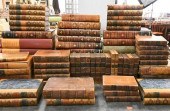 LARGE COLLECTION OF LEATHER BOUND
LARGE COLLECTION OF LEATHER BOUND BOOKSLarge Collection of Leather Bound Books, to include a first edition copy of "The Life of Lewis Bourbon, Late Prince of Conde", published in 1693; along with one volume of "The Plays of Philip Massinger", authored by W. Gifford, published in 1805, having handwritten signed letter by W. Gifford, "Secret Memoirs of the Court of Louis XIV", published in 1824; volumes 1 and 2 of "History of European Morals", by Lecky; two volumes of "Memoires Du Cardinal De Retz", published in 1731; "Arcana Gallica" or "The Secret History of France Published in 1714", "The Memoirs of Philip de Comines Lord of Argenton", published in 1674; along with "The Post Boy Robb'd of His Mail", second edition, published in 1706, Complete Leather Bound First Edition Set of The Adventures of Ferdinand Count Fathom, by Roderick Random, published 1753 in London, Limited Edition Don Quixote "Cervantes", to include volumes 1, 2, 3, and 4, published in 1906 by Charles Scribner's Sons, a complete five volume set of "Memoirs for The History of Anne of Austria", published in 1726, a complete 20 volume set of "The Percy Anecdotes" by Sholto and Reuben Percy, published in 1823, a complete first edition "Windor's History of America" comprised of eight volumes, published in 1886, complete set of "De Quincey's Works" comprised of fifteen volumes, three volumes of "Commodore Perry's Voyages", by Francis L. Hawks, "Narrative of the Expedition of an American Squadron to the China Seas and Japan", preformed in the years 1852, 1853 and 1854, under command of Commodore M.C. Perry, United States Navy, by order of the goverment of the United States, published in 1856, sold as is, lot has condition issues and odor, Provenance: Estate of Cyril H. Moore Jr, Kent, Connecticut. Condition: All lots are sold "AS IS" The condition of lots can vary widely and are unlikely to be in a perfect condition. *No credit card payments will be accepted for silver, gold, or jewelry from buyers that have not purchased from our gallery in the past.
LARGE COLLECTION OF LEATHER BOUND
LARGE COLLECTION OF LEATHER BOUND BOOKSLarge Collection of Leather Bound Books, to include a first edition copy of "The Life of Lewis Bourbon, Late Prince of Conde", published in 1693; along with one volume of "The Plays of Philip Massinger", authored by W. Gifford, published in 1805, having handwritten signed letter by W. Gifford, "Secret Memoirs of the Court of Louis XIV", published in 1824; volumes 1 and 2 of "History of European Morals", by Lecky; two volumes of "Memoires Du Cardinal De Retz", published in 1731; "Arcana Gallica" or "The Secret History of France Published in 1714", "The Memoirs of Philip de Comines Lord of Argenton", published in 1674; along with "The Post Boy Robb'd of His Mail", second edition, published in 1706, Complete Leather Bound First Edition Set of The Adventures of Ferdinand Count Fathom, by Roderick Random, published 1753 in London, Limited Edition Don Quixote "Cervantes", to include volumes 1, 2, 3, and 4, published in 1906 by Charles Scribner's Sons, a complete five volume set of "Memoirs for The History of Anne of Austria", published in 1726, a complete 20 volume set of "The Percy Anecdotes" by Sholto and Reuben Percy, published in 1823, a complete first edition "Windor's History of America" comprised of eight volumes, published in 1886, complete set of "De Quincey's Works" comprised of fifteen volumes, three volumes of "Commodore Perry's Voyages", by Francis L. Hawks, "Narrative of the Expedition of an American Squadron to the China Seas and Japan", preformed in the years 1852, 1853 and 1854, under command of Commodore M.C. Perry, United States Navy, by order of the goverment of the United States, published in 1856, sold as is, lot has condition issues and odor, Provenance: Estate of Cyril H. Moore Jr, Kent, Connecticut. Condition: All lots are sold "AS IS" The condition of lots can vary widely and are unlikely to be in a perfect condition. *No credit card payments will be accepted for silver, gold, or jewelry from buyers that have not purchased from our gallery in the past. -
 125. SILVER “WIENER WERKSTäTTEN”
125. SILVER “WIENER WERKSTäTTEN” DRESS CANE -CA. 1900 -...125. Silver “Wiener Werkstätten” Dress Cane -Ca. 1900 -Large silver crook handle with a longer and pointed nose decorated in the best “Wiener Werkstätten” or Viennese Workshops taste with applied gorgeous stylized floral elements in a trendsetting, interlaced and modernistic Art Nouveau design. It bears the Austro-Hungarian Empire silver mark for small articles in use from 1867-1922 beside a “WB” maker’s mark and an “800” for the silver title and comes on a smooth and well-streaked partridge shaft and a brass ferrule. The distinctive iconic design of this cane makes of it a first rate collectable. Age complimented the cane and it survived in original condition. -The Wiener Werkstätte (literally Viennese Workshops), a similar idea to Ashbee’s Guild of Handicraft, was officially registered on May 19,1903 as a craftsmen cooperative, producing furniture, metalwork, textiles, glassware, and ceramics (the latter mainly in conjunction with the Wiener Keramik factory, founded in 1906 by Bertold Loffler and Michael Powolny). The Werkstätte’s aims were spelt out in the Arbeitsprogramm, a working program published by Hoffmann and Moser in 1905. Aesthetically, the Werkstätte pursued the innovations of Jugendstil as popularized by the Vienna Secession from 1897. From the outset, despite the patronage of Adolphe Stoclet and textile magnate Fritz Warndorfer, the Werkstätte struggled to achieve economic viability; Moser left, partly for money reasons, in 1907 but Werkstätte continued in existence until 1932. Last year Vienna celebrated the centenary of the Wiener Werkstätte with various museum and gallery exhibitions, which also showed many cane handles. -H. 3 ½” x 4”, O.L. 34 ½” -$500-$900
125. SILVER “WIENER WERKSTäTTEN”
125. SILVER “WIENER WERKSTäTTEN” DRESS CANE -CA. 1900 -...125. Silver “Wiener Werkstätten” Dress Cane -Ca. 1900 -Large silver crook handle with a longer and pointed nose decorated in the best “Wiener Werkstätten” or Viennese Workshops taste with applied gorgeous stylized floral elements in a trendsetting, interlaced and modernistic Art Nouveau design. It bears the Austro-Hungarian Empire silver mark for small articles in use from 1867-1922 beside a “WB” maker’s mark and an “800” for the silver title and comes on a smooth and well-streaked partridge shaft and a brass ferrule. The distinctive iconic design of this cane makes of it a first rate collectable. Age complimented the cane and it survived in original condition. -The Wiener Werkstätte (literally Viennese Workshops), a similar idea to Ashbee’s Guild of Handicraft, was officially registered on May 19,1903 as a craftsmen cooperative, producing furniture, metalwork, textiles, glassware, and ceramics (the latter mainly in conjunction with the Wiener Keramik factory, founded in 1906 by Bertold Loffler and Michael Powolny). The Werkstätte’s aims were spelt out in the Arbeitsprogramm, a working program published by Hoffmann and Moser in 1905. Aesthetically, the Werkstätte pursued the innovations of Jugendstil as popularized by the Vienna Secession from 1897. From the outset, despite the patronage of Adolphe Stoclet and textile magnate Fritz Warndorfer, the Werkstätte struggled to achieve economic viability; Moser left, partly for money reasons, in 1907 but Werkstätte continued in existence until 1932. Last year Vienna celebrated the centenary of the Wiener Werkstätte with various museum and gallery exhibitions, which also showed many cane handles. -H. 3 ½” x 4”, O.L. 34 ½” -$500-$900 -
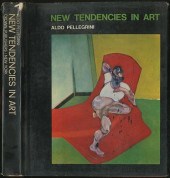 16 REFERENCE BOOKS16 vintage
16 REFERENCE BOOKS16 vintage reference books: -New tendencies in art by Aldo Pellegrini. - The great Book Of French Impressionism By Horst Keller. -The World Of Van Gogh 1853- 1890 by Robert Wallace and the editors of time-life books. -The World Of Delacroix 1798- 1863 by Tom Prideaux. -The World Of Leonard 1452-1519 by Robert Wallace. -The World Of Cezanne 1839-1906 by Richard W. Murphy. - Hermitage Leningrad By Vitaly Suslov. - Van Gogh by Keith Wheldon. - The Bilderbuch By R.F. Bon Frenbold. The World Of Goya 1746-1828 By Richard Schickel. - Degas- Metropolitan Museum of Art. - A ngels From The Vatican. -The World Of Picasso By Lael Wertenbaker. - South Beach Style By Laura Cerwinske. -Japan A History Of Art By Bradley Smith. - Portrait De Michele.
16 REFERENCE BOOKS16 vintage
16 REFERENCE BOOKS16 vintage reference books: -New tendencies in art by Aldo Pellegrini. - The great Book Of French Impressionism By Horst Keller. -The World Of Van Gogh 1853- 1890 by Robert Wallace and the editors of time-life books. -The World Of Delacroix 1798- 1863 by Tom Prideaux. -The World Of Leonard 1452-1519 by Robert Wallace. -The World Of Cezanne 1839-1906 by Richard W. Murphy. - Hermitage Leningrad By Vitaly Suslov. - Van Gogh by Keith Wheldon. - The Bilderbuch By R.F. Bon Frenbold. The World Of Goya 1746-1828 By Richard Schickel. - Degas- Metropolitan Museum of Art. - A ngels From The Vatican. -The World Of Picasso By Lael Wertenbaker. - South Beach Style By Laura Cerwinske. -Japan A History Of Art By Bradley Smith. - Portrait De Michele. -
 PHOTO #48 49 50, JO MORA HOPI
PHOTO #48 49 50, JO MORA HOPI TEWA VILLAGERare photograph, taken between 1904-1906 by Joseph Jacinto Mora (American, 1876-1947), one of the last known images taken from Mora's original negative. (Photo numbers represent nothing more than inventory stickers on verso.) After 1912, cameras were banned from the reservation. Photos depict scenes of Tewa village, first mesa, including a burro. Sepia, unmatted and untrimmed. Measure about 11x14 overall. The images in this collection were part of a Smithsonian traveling exhibition (SITES) of Jo Mora's work, which ran from 1979-1981, after which the negatives were donated to a university museum. Honoring a request by the Hopi Tribe, the museum agreed that unless permission were granted by the Hopi, no new photos will ever be made from the negatives depicting these sacred ceremonies. Provenance: Obtained from Mora family in the 1970s by John R. Wilson, along with original negatives and other Mora art works. Wilson exhibited the photos in 1976 at the Alexandre Hogue Gallery, University of Tulsa, then lent them to the Smithsonian to be part of their SITES exhibition in 1979. He subsequently donated the negatives to Northern Arizona University's Cline Library. Wilson sold the photographs to the consignor. Sources: Jo Mora Trust. Smithsonian Institution Traveling Exhibition Service. Noticias del Puerto de Monterey (Quarterly Bulletin of the Monterey History and Art Association), Fall 2003 issue.
PHOTO #48 49 50, JO MORA HOPI
PHOTO #48 49 50, JO MORA HOPI TEWA VILLAGERare photograph, taken between 1904-1906 by Joseph Jacinto Mora (American, 1876-1947), one of the last known images taken from Mora's original negative. (Photo numbers represent nothing more than inventory stickers on verso.) After 1912, cameras were banned from the reservation. Photos depict scenes of Tewa village, first mesa, including a burro. Sepia, unmatted and untrimmed. Measure about 11x14 overall. The images in this collection were part of a Smithsonian traveling exhibition (SITES) of Jo Mora's work, which ran from 1979-1981, after which the negatives were donated to a university museum. Honoring a request by the Hopi Tribe, the museum agreed that unless permission were granted by the Hopi, no new photos will ever be made from the negatives depicting these sacred ceremonies. Provenance: Obtained from Mora family in the 1970s by John R. Wilson, along with original negatives and other Mora art works. Wilson exhibited the photos in 1976 at the Alexandre Hogue Gallery, University of Tulsa, then lent them to the Smithsonian to be part of their SITES exhibition in 1979. He subsequently donated the negatives to Northern Arizona University's Cline Library. Wilson sold the photographs to the consignor. Sources: Jo Mora Trust. Smithsonian Institution Traveling Exhibition Service. Noticias del Puerto de Monterey (Quarterly Bulletin of the Monterey History and Art Association), Fall 2003 issue. -
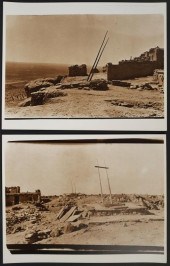 PHOTOS #45 46 47, JO MORA
PHOTOS #45 46 47, JO MORA HOPIRare photograph, taken between 1904-1906 by Joseph Jacinto Mora (American, 1876-1947), one of the last known images taken from Mora's original negative. (Photo numbers represent nothing more than inventory stickers on verso.) After 1912, cameras were banned from the reservation. Photographs depict kivas with ladders. Kivas were underground rooms, made for ceremonial purposes, often to represent the underworld. Sepia, unmatted and untrimmed. Measure about 11x14 overall. The images in this collection were part of a Smithsonian traveling exhibition (SITES) of Jo Mora's work, which ran from 1979-1981, after which the negatives were donated to a university museum. Honoring a request by the Hopi Tribe, the museum agreed that unless permission were granted by the Hopi, no new photos will ever be made from the negatives depicting these sacred ceremonies. Provenance: Obtained from Mora family in the 1970s by John R. Wilson, along with original negatives and other Mora art works. Wilson exhibited the photos in 1976 at the Alexandre Hogue Gallery, University of Tulsa, then lent them to the Smithsonian to be part of their SITES exhibition in 1979. He subsequently donated the negatives to Northern Arizona University's Cline Library. Wilson sold the photographs to the consignor. Sources: Jo Mora Trust. Smithsonian Institution Traveling Exhibition Service. Noticias del Puerto de Monterey (Quarterly Bulletin of the Monterey History and Art Association), Fall 2003 issue.
PHOTOS #45 46 47, JO MORA
PHOTOS #45 46 47, JO MORA HOPIRare photograph, taken between 1904-1906 by Joseph Jacinto Mora (American, 1876-1947), one of the last known images taken from Mora's original negative. (Photo numbers represent nothing more than inventory stickers on verso.) After 1912, cameras were banned from the reservation. Photographs depict kivas with ladders. Kivas were underground rooms, made for ceremonial purposes, often to represent the underworld. Sepia, unmatted and untrimmed. Measure about 11x14 overall. The images in this collection were part of a Smithsonian traveling exhibition (SITES) of Jo Mora's work, which ran from 1979-1981, after which the negatives were donated to a university museum. Honoring a request by the Hopi Tribe, the museum agreed that unless permission were granted by the Hopi, no new photos will ever be made from the negatives depicting these sacred ceremonies. Provenance: Obtained from Mora family in the 1970s by John R. Wilson, along with original negatives and other Mora art works. Wilson exhibited the photos in 1976 at the Alexandre Hogue Gallery, University of Tulsa, then lent them to the Smithsonian to be part of their SITES exhibition in 1979. He subsequently donated the negatives to Northern Arizona University's Cline Library. Wilson sold the photographs to the consignor. Sources: Jo Mora Trust. Smithsonian Institution Traveling Exhibition Service. Noticias del Puerto de Monterey (Quarterly Bulletin of the Monterey History and Art Association), Fall 2003 issue. -
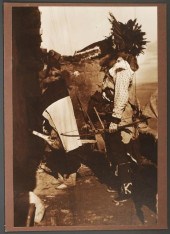 PHOTO #36, JO MORA HOPI KACHINA &
PHOTO #36, JO MORA HOPI KACHINA & OGRERare photograph, taken between 1904-1906 by Joseph Jacinto Mora (American, 1876-1947), one of the last known images taken from Mora's original negative. (Photo number represents nothing more than an inventory sticker on verso.) After 1912, cameras were banned from the reservation. Depicts Hahai Wugti, mother of the Kachinas, at a doof with black male ogre. Sepia, matted. Measures 10" x 14" overall. The images in this collection were part of a Smithsonian traveling exhibition (SITES) of Jo Mora’s work, which ran from 1979-1981, after which the negatives were donated to a university museum. Honoring a request by the Hopi Tribe, the museum agreed that unless permission were granted by the Hopi, no new photos will ever be made from the negatives depicting these sacred ceremonies. Provenance: Obtained from Mora family in the 1970s by John R. Wilson, along with original negatives and other Mora's art works. Wilson exhibited the photos in 1976 at the Alexandre Hogue Gallery, University of Tulsa, then lent them to the Smithsonian to be part of their SITES exhibition in 1979. He subsequently donated the negatives to Northern Arizona University's Cline Library. Wilson sold the photographs to the consignor. Sources: Jo Mora Trust. Smithsonian Institution Traveling Exhibition Service. Noticias del Puerto de Monterey (Quarterly Bulletin of the Monterey History and Art Association), Fall 2003 issue.
PHOTO #36, JO MORA HOPI KACHINA &
PHOTO #36, JO MORA HOPI KACHINA & OGRERare photograph, taken between 1904-1906 by Joseph Jacinto Mora (American, 1876-1947), one of the last known images taken from Mora's original negative. (Photo number represents nothing more than an inventory sticker on verso.) After 1912, cameras were banned from the reservation. Depicts Hahai Wugti, mother of the Kachinas, at a doof with black male ogre. Sepia, matted. Measures 10" x 14" overall. The images in this collection were part of a Smithsonian traveling exhibition (SITES) of Jo Mora’s work, which ran from 1979-1981, after which the negatives were donated to a university museum. Honoring a request by the Hopi Tribe, the museum agreed that unless permission were granted by the Hopi, no new photos will ever be made from the negatives depicting these sacred ceremonies. Provenance: Obtained from Mora family in the 1970s by John R. Wilson, along with original negatives and other Mora's art works. Wilson exhibited the photos in 1976 at the Alexandre Hogue Gallery, University of Tulsa, then lent them to the Smithsonian to be part of their SITES exhibition in 1979. He subsequently donated the negatives to Northern Arizona University's Cline Library. Wilson sold the photographs to the consignor. Sources: Jo Mora Trust. Smithsonian Institution Traveling Exhibition Service. Noticias del Puerto de Monterey (Quarterly Bulletin of the Monterey History and Art Association), Fall 2003 issue. -
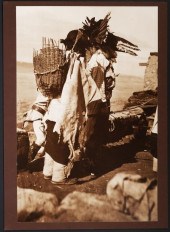 PHOTO #35, JO MORA HOPI MALE &
PHOTO #35, JO MORA HOPI MALE & FEMALE OGRESRare photograph, taken between 1904-1906 by Joseph Jacinto Mora (American, 1876-1947), one of the last known images taken from Mora's original negative. (Photo number represents nothing more than an inventory sticker on verso.) After 1912, cameras were banned from the reservation. Depicts three figures, including Soyoko ogre woman (with basket on back) and male ogre holding bow. Sepia, matted. Measures 10" x 14" overall. The images in this collection were part of a Smithsonian traveling exhibition (SITES) of Jo Moras work, which ran from 1979-1981, after which the negatives were donated to a university museum. Honoring a request by the Hopi Tribe, the museum agreed that unless permission were granted by the Hopi, no new photos will ever be made from the negatives depicting these sacred ceremonies. Provenance: Obtained from Mora family in the 1970s by John R. Wilson, along with original negatives and other Mora art works. Wilson exhibited the photos in 1976 at the Alexandre Hogue Gallery, University of Tulsa, then lent them to the Smithsonian to be part of their SITES exhibition in 1979. He subsequently donated the negatives to Northern Arizona University's Cline Library. Wilson sold the photographs to the consignor. Sources: Jo Mora Trust. Smithsonian Institution Traveling Exhibition Service. Noticias del Puerto de Monterey (Quarterly Bulletin of the Monterey History and Art Association), Fall 2003 issue.
PHOTO #35, JO MORA HOPI MALE &
PHOTO #35, JO MORA HOPI MALE & FEMALE OGRESRare photograph, taken between 1904-1906 by Joseph Jacinto Mora (American, 1876-1947), one of the last known images taken from Mora's original negative. (Photo number represents nothing more than an inventory sticker on verso.) After 1912, cameras were banned from the reservation. Depicts three figures, including Soyoko ogre woman (with basket on back) and male ogre holding bow. Sepia, matted. Measures 10" x 14" overall. The images in this collection were part of a Smithsonian traveling exhibition (SITES) of Jo Moras work, which ran from 1979-1981, after which the negatives were donated to a university museum. Honoring a request by the Hopi Tribe, the museum agreed that unless permission were granted by the Hopi, no new photos will ever be made from the negatives depicting these sacred ceremonies. Provenance: Obtained from Mora family in the 1970s by John R. Wilson, along with original negatives and other Mora art works. Wilson exhibited the photos in 1976 at the Alexandre Hogue Gallery, University of Tulsa, then lent them to the Smithsonian to be part of their SITES exhibition in 1979. He subsequently donated the negatives to Northern Arizona University's Cline Library. Wilson sold the photographs to the consignor. Sources: Jo Mora Trust. Smithsonian Institution Traveling Exhibition Service. Noticias del Puerto de Monterey (Quarterly Bulletin of the Monterey History and Art Association), Fall 2003 issue. -
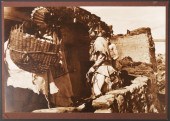 PHOTO #32, JO MORA HOPI FOUR
PHOTO #32, JO MORA HOPI FOUR KACHINASRare photograph, taken between 1904-1906 by Joseph Jacinto Mora (American, 1876-1947), one of the last known images taken from Mora's original negative. (Photo number represents nothing more than an inventory sticker on verso.) After 1912, cameras were banned from the reservation. Depicts four figures at a door, Powamu festival. Includes Soyoko ogre woman, male black ogre, Jejeya kachina, and Poo Wha Muich albino kachina. Sepia, matted. Measures 10" x 14" overall. The images in this collection were part of a Smithsonian traveling exhibition (SITES) of Jo Mora's work, which ran from 1979-1981, after which the negatives were donated to a university museum. Honoring a request by the Hopi Tribe, the museum agreed that unless permission were granted by the Hopi, no new photos will ever be made from the negatives depicting these sacred ceremonies. Provenance: Obtained from Mora family in the 1970s by John R. Wilson, along with original negatives and other Mora art works. Wilson exhibited the photos in 1976 at the Alexandre Hogue Gallery, University of Tulsa, then lent them to the Smithsonian to be part of their SITES exhibition in 1979. He subsequently donated the negatives to Northern Arizona University's Cline Library. Wilson sold the photographs to the consignor. Sources: Jo Mora Trust. Smithsonian Institution Traveling Exhibition Service. Noticias del Puerto de Monterey (Quarterly Bulletin of the Monterey History and Art Association), Fall 2003 issue.
PHOTO #32, JO MORA HOPI FOUR
PHOTO #32, JO MORA HOPI FOUR KACHINASRare photograph, taken between 1904-1906 by Joseph Jacinto Mora (American, 1876-1947), one of the last known images taken from Mora's original negative. (Photo number represents nothing more than an inventory sticker on verso.) After 1912, cameras were banned from the reservation. Depicts four figures at a door, Powamu festival. Includes Soyoko ogre woman, male black ogre, Jejeya kachina, and Poo Wha Muich albino kachina. Sepia, matted. Measures 10" x 14" overall. The images in this collection were part of a Smithsonian traveling exhibition (SITES) of Jo Mora's work, which ran from 1979-1981, after which the negatives were donated to a university museum. Honoring a request by the Hopi Tribe, the museum agreed that unless permission were granted by the Hopi, no new photos will ever be made from the negatives depicting these sacred ceremonies. Provenance: Obtained from Mora family in the 1970s by John R. Wilson, along with original negatives and other Mora art works. Wilson exhibited the photos in 1976 at the Alexandre Hogue Gallery, University of Tulsa, then lent them to the Smithsonian to be part of their SITES exhibition in 1979. He subsequently donated the negatives to Northern Arizona University's Cline Library. Wilson sold the photographs to the consignor. Sources: Jo Mora Trust. Smithsonian Institution Traveling Exhibition Service. Noticias del Puerto de Monterey (Quarterly Bulletin of the Monterey History and Art Association), Fall 2003 issue. -
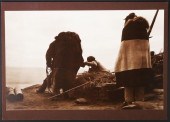 PHOTO #25, JO MORA HOPI AKWANTI
PHOTO #25, JO MORA HOPI AKWANTI FESTIVALRare photograph, taken between 1904-1906 by Joseph Jacinto Mora (American, 1876-1947), one of the last known images taken from Mora's original negative. (Photo number represents nothing more than an inventory sticker on verso.) After 1912, cameras were banned from the reservation. Depicts figures, two next to Kiva, releasing old man from the underworld by the underworld deity during Ankwanti Festival. To the right is Hahai Wugti, mother of the kachinas. Sepia, matted. Measures 10" x 14" overall. The images in this collection were part of a Smithsonian traveling exhibition (SITES) of Jo Mora's work, which ran from 1979-1981, after which the negatives were donated to a university museum. Honoring a request by the Hopi Tribe, the museum agreed that unless permission were granted by the Hopi, no new photos will ever be made from the negatives depicting these sacred ceremonies. Provenance: Obtained from Mora family in the 1970s by John R. Wilson, along with original negatives and other Mora art works. Wilson exhibited the photos in 1976 at the Alexandre Hogue Gallery, University of Tulsa, then lent them to the Smithsonian to be part of their SITES exhibition in 1979. He subsequently donated the negatives to Northern Arizona University's Cline Library. Wilson sold the photographs to the consignor. Sources: Jo Mora Trust. Smithsonian Institution Traveling Exhibition Service. Noticias del Puerto de Monterey (Quarterly Bulletin of the Monterey History and Art Association), Fall 2003 issue.
PHOTO #25, JO MORA HOPI AKWANTI
PHOTO #25, JO MORA HOPI AKWANTI FESTIVALRare photograph, taken between 1904-1906 by Joseph Jacinto Mora (American, 1876-1947), one of the last known images taken from Mora's original negative. (Photo number represents nothing more than an inventory sticker on verso.) After 1912, cameras were banned from the reservation. Depicts figures, two next to Kiva, releasing old man from the underworld by the underworld deity during Ankwanti Festival. To the right is Hahai Wugti, mother of the kachinas. Sepia, matted. Measures 10" x 14" overall. The images in this collection were part of a Smithsonian traveling exhibition (SITES) of Jo Mora's work, which ran from 1979-1981, after which the negatives were donated to a university museum. Honoring a request by the Hopi Tribe, the museum agreed that unless permission were granted by the Hopi, no new photos will ever be made from the negatives depicting these sacred ceremonies. Provenance: Obtained from Mora family in the 1970s by John R. Wilson, along with original negatives and other Mora art works. Wilson exhibited the photos in 1976 at the Alexandre Hogue Gallery, University of Tulsa, then lent them to the Smithsonian to be part of their SITES exhibition in 1979. He subsequently donated the negatives to Northern Arizona University's Cline Library. Wilson sold the photographs to the consignor. Sources: Jo Mora Trust. Smithsonian Institution Traveling Exhibition Service. Noticias del Puerto de Monterey (Quarterly Bulletin of the Monterey History and Art Association), Fall 2003 issue. -
 PHOTO #24, JO MORA HOPI ANKWANTI
PHOTO #24, JO MORA HOPI ANKWANTI FESTIVALRare photograph, taken between 1904-1906 by Joseph Jacinto Mora (American, 1876-1947), one of the last known images taken from Mora's original negative. (Photo number represents nothing more than an inventory sticker on verso.) After 1912, cameras were banned from the reservation. Depicts two figures, one standing next to kiva during Ankwanti festival. Sepia, matted. Measures 10" x 14" overall. The images in this collection were part of a Smithsonian traveling exhibition (SITES) of Jo Mora's work, which ran from 1979-1981, after which the negatives were donated to a university museum. Honoring a request by the Hopi Tribe, the museum agreed that unless permission were granted by the Hopi, no new photos will ever be made from the negatives depicting these sacred ceremonies. Provenance: Obtained from Mora family in the 1970s by John R. Wilson, along with original negatives and other Mora art works. Wilson exhibited the photos in 1976 at the Alexandre Hogue Gallery, University of Tulsa, then lent them to the Smithsonian to be part of their SITES exhibition in 1979. He subsequently donated the negatives to Northern Arizona University's Cline Library. Wilson sold the photographs to the consignor. Sources: Jo Mora Trust. Smithsonian Institution Traveling Exhibition Service. Noticias del Puerto de Monterey (Quarterly Bulletin of the Monterey History and Art Association), Fall 2003 issue.
PHOTO #24, JO MORA HOPI ANKWANTI
PHOTO #24, JO MORA HOPI ANKWANTI FESTIVALRare photograph, taken between 1904-1906 by Joseph Jacinto Mora (American, 1876-1947), one of the last known images taken from Mora's original negative. (Photo number represents nothing more than an inventory sticker on verso.) After 1912, cameras were banned from the reservation. Depicts two figures, one standing next to kiva during Ankwanti festival. Sepia, matted. Measures 10" x 14" overall. The images in this collection were part of a Smithsonian traveling exhibition (SITES) of Jo Mora's work, which ran from 1979-1981, after which the negatives were donated to a university museum. Honoring a request by the Hopi Tribe, the museum agreed that unless permission were granted by the Hopi, no new photos will ever be made from the negatives depicting these sacred ceremonies. Provenance: Obtained from Mora family in the 1970s by John R. Wilson, along with original negatives and other Mora art works. Wilson exhibited the photos in 1976 at the Alexandre Hogue Gallery, University of Tulsa, then lent them to the Smithsonian to be part of their SITES exhibition in 1979. He subsequently donated the negatives to Northern Arizona University's Cline Library. Wilson sold the photographs to the consignor. Sources: Jo Mora Trust. Smithsonian Institution Traveling Exhibition Service. Noticias del Puerto de Monterey (Quarterly Bulletin of the Monterey History and Art Association), Fall 2003 issue. -
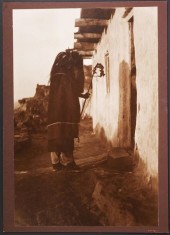 PHOTO #23, JO MORA HOPI AKWANTI
PHOTO #23, JO MORA HOPI AKWANTI FESTIVALRare photograph, taken between 1904-1906 by Joseph Jacinto Mora (American, 1876-1947), one of the last known images taken from Mora's original negative. (Photo number represents nothing more than an inventory sticker on verso.) After 1912, cameras were banned from the reservation. Depicts figure standing at door during Akwanti festival. Figure is believed to represent the god of the underworld trying to lure villagers out of their homes. Sepia, matted. Measures 10" x 14" overall. The images in this collection were part of a Smithsonian traveling exhibition (SITES) of Jo Mora's work, which ran from 1979-1981, after which the negatives were donated to a university museum. Honoring a request by the Hopi Tribe, the museum agreed that unless permission were granted by the Hopi, no new photos will ever be made from the negatives depicting these sacred ceremonies. Provenance: Obtained from Mora family in the 1970s by John R. Wilson, along with original negatives and other Mora art works. Wilson exhibited the photos in 1976 at the Alexandre Hogue Gallery, University of Tulsa, then lent them to the Smithsonian to be part of their SITES exhibition in 1979. He subsequently donated the negatives to Northern Arizona University's Cline Library. Wilson sold the photographs to the consignor. Sources: Jo Mora Trust. Smithsonian Institution Traveling Exhibition Service. Noticias del Puerto de Monterey (Quarterly Bulletin of the Monterey History and Art Association), Fall 2003 issue.
PHOTO #23, JO MORA HOPI AKWANTI
PHOTO #23, JO MORA HOPI AKWANTI FESTIVALRare photograph, taken between 1904-1906 by Joseph Jacinto Mora (American, 1876-1947), one of the last known images taken from Mora's original negative. (Photo number represents nothing more than an inventory sticker on verso.) After 1912, cameras were banned from the reservation. Depicts figure standing at door during Akwanti festival. Figure is believed to represent the god of the underworld trying to lure villagers out of their homes. Sepia, matted. Measures 10" x 14" overall. The images in this collection were part of a Smithsonian traveling exhibition (SITES) of Jo Mora's work, which ran from 1979-1981, after which the negatives were donated to a university museum. Honoring a request by the Hopi Tribe, the museum agreed that unless permission were granted by the Hopi, no new photos will ever be made from the negatives depicting these sacred ceremonies. Provenance: Obtained from Mora family in the 1970s by John R. Wilson, along with original negatives and other Mora art works. Wilson exhibited the photos in 1976 at the Alexandre Hogue Gallery, University of Tulsa, then lent them to the Smithsonian to be part of their SITES exhibition in 1979. He subsequently donated the negatives to Northern Arizona University's Cline Library. Wilson sold the photographs to the consignor. Sources: Jo Mora Trust. Smithsonian Institution Traveling Exhibition Service. Noticias del Puerto de Monterey (Quarterly Bulletin of the Monterey History and Art Association), Fall 2003 issue. -
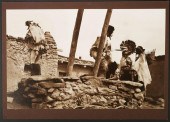 PHOTO #22, JO MORA HOPI KACHINAS
PHOTO #22, JO MORA HOPI KACHINAS & KIVARare photograph, taken between 1904-1906 by Joseph Jacinto Mora (American, 1876-1947), one of the last known images taken from Mora's original negative. (Photo number represents nothing more than an inventory sticker on verso.) After 1912, cameras were banned from the reservation. Depicts four figures standing by kiva during Ankwanti festival. Sepia, matted. Measures 10" x 14" overall. The images in this collection were part of a Smithsonian traveling exhibition (SITES) of Jo Mora's work, which ran from 1979-1981, after which the negatives were donated to a university museum. Honoring a request by the Hopi Tribe, the museum agreed that unless permission were granted by the Hopi, no new photos will ever be made from the negatives depicting these sacred ceremonies. Provenance: Obtained from Mora family in the 1970s by John R. Wilson, along with original negatives and other Mora art works. Wilson exhibited the photos in 1976 at the Alexandre Hogue Gallery, University of Tulsa, then lent them to the Smithsonian to be part of their SITES exhibition in 1979. He subsequently donated the negatives to Northern Arizona University's Cline Library. Wilson sold the photographs to the consignor. Sources: Jo Mora Trust. Smithsonian Institution Traveling Exhibition Service. Noticias del Puerto de Monterey (Quarterly Bulletin of the Monterey History and Art Association), Fall 2003 issue.
PHOTO #22, JO MORA HOPI KACHINAS
PHOTO #22, JO MORA HOPI KACHINAS & KIVARare photograph, taken between 1904-1906 by Joseph Jacinto Mora (American, 1876-1947), one of the last known images taken from Mora's original negative. (Photo number represents nothing more than an inventory sticker on verso.) After 1912, cameras were banned from the reservation. Depicts four figures standing by kiva during Ankwanti festival. Sepia, matted. Measures 10" x 14" overall. The images in this collection were part of a Smithsonian traveling exhibition (SITES) of Jo Mora's work, which ran from 1979-1981, after which the negatives were donated to a university museum. Honoring a request by the Hopi Tribe, the museum agreed that unless permission were granted by the Hopi, no new photos will ever be made from the negatives depicting these sacred ceremonies. Provenance: Obtained from Mora family in the 1970s by John R. Wilson, along with original negatives and other Mora art works. Wilson exhibited the photos in 1976 at the Alexandre Hogue Gallery, University of Tulsa, then lent them to the Smithsonian to be part of their SITES exhibition in 1979. He subsequently donated the negatives to Northern Arizona University's Cline Library. Wilson sold the photographs to the consignor. Sources: Jo Mora Trust. Smithsonian Institution Traveling Exhibition Service. Noticias del Puerto de Monterey (Quarterly Bulletin of the Monterey History and Art Association), Fall 2003 issue. -
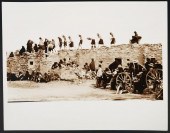 PHOTO #17, JO MORA HOPI MUDHEAD
PHOTO #17, JO MORA HOPI MUDHEAD CLOWNSRare photograph, taken between 1904-1906 by Joseph Jacinto Mora (American, 1876-1947), one of the last known images taken from Mora's original negative. (Photo number represents nothing more than an inventory sticker on verso.) After 1912, cameras were banned from the reservation. Depicts Koyemsi (mudhead clowns) entering from roofs of homes to plaza below. Sepia, unmatted and untrimmed. Measures about 11x14 overall. The images in this collection were part of a Smithsonian traveling exhibition (SITES) of Jo Mora's work, which ran from 1979-1981, after which the negatives were donated to a university museum. Honoring a request by the Hopi Tribe, the museum agreed that unless permission were granted by the Hopi, no new photos will ever be made from the negatives depicting these sacred ceremonies. Provenance: Obtained from Mora family in the 1970s by John R. Wilson, along with original negatives and other Mora art works. Wilson exhibited the photos in 1976 at the Alexandre Hogue Gallery, University of Tulsa, then lent them to the Smithsonian to be part of their SITES exhibition in 1979. He subsequently donated the negatives to Northern Arizona University's Cline Library. Wilson sold the photographs to the consignor. Sources: Jo Mora Trust. Smithsonian Institution Traveling Exhibition Service. Noticias del Puerto de Monterey (Quarterly Bulletin of the Monterey History and Art Association), Fall 2003 issue.
PHOTO #17, JO MORA HOPI MUDHEAD
PHOTO #17, JO MORA HOPI MUDHEAD CLOWNSRare photograph, taken between 1904-1906 by Joseph Jacinto Mora (American, 1876-1947), one of the last known images taken from Mora's original negative. (Photo number represents nothing more than an inventory sticker on verso.) After 1912, cameras were banned from the reservation. Depicts Koyemsi (mudhead clowns) entering from roofs of homes to plaza below. Sepia, unmatted and untrimmed. Measures about 11x14 overall. The images in this collection were part of a Smithsonian traveling exhibition (SITES) of Jo Mora's work, which ran from 1979-1981, after which the negatives were donated to a university museum. Honoring a request by the Hopi Tribe, the museum agreed that unless permission were granted by the Hopi, no new photos will ever be made from the negatives depicting these sacred ceremonies. Provenance: Obtained from Mora family in the 1970s by John R. Wilson, along with original negatives and other Mora art works. Wilson exhibited the photos in 1976 at the Alexandre Hogue Gallery, University of Tulsa, then lent them to the Smithsonian to be part of their SITES exhibition in 1979. He subsequently donated the negatives to Northern Arizona University's Cline Library. Wilson sold the photographs to the consignor. Sources: Jo Mora Trust. Smithsonian Institution Traveling Exhibition Service. Noticias del Puerto de Monterey (Quarterly Bulletin of the Monterey History and Art Association), Fall 2003 issue. -
 JO MORA HOPI MASKED OGRE
JO MORA HOPI MASKED OGRE PHOTOGRAPHRare photograph, taken between 1904-1906 by Joseph Jacinto Mora (American, 1876-1947), one of the last known images taken from Mora's original negative. Inventory sticker on verso. After 1912, cameras were banned from the reservation. Depicts black and white male ogre with bows, taken during Powamu Festival. Sepia, unmatted. Measures about 11" x 14" overall. The images in this collection were part of a Smithsonian traveling exhibition (SITES) of Jo Mora’s work, which ran from 1979-1981, after which the negatives were donated to a university museum. Honoring a request by the Hopi Tribe, the museum agreed that unless permission were granted by the Hopi, no new photos will ever be made from the negatives depicting these sacred ceremonies. Provenance: Obtained from Mora family in the 1970s by John R. Wilson, along with original negatives and other Mora art works. Wilson exhibited the photos in 1976 at the Alexandre Hogue Gallery, University of Tulsa, then lent them to the Smithsonian to be part of their SITES exhibition in 1979. He subsequently donated the negatives to Northern Arizona University's Cline Library. Wilson sold the photographs to the consignor. Sources: Jo Mora Trust. Smithsonian Institution Traveling Exhibition Service. Noticias del Puerto de Monterey (Quarterly Bulletin of the Monterey History and Art Association), Fall 2003 issue.
JO MORA HOPI MASKED OGRE
JO MORA HOPI MASKED OGRE PHOTOGRAPHRare photograph, taken between 1904-1906 by Joseph Jacinto Mora (American, 1876-1947), one of the last known images taken from Mora's original negative. Inventory sticker on verso. After 1912, cameras were banned from the reservation. Depicts black and white male ogre with bows, taken during Powamu Festival. Sepia, unmatted. Measures about 11" x 14" overall. The images in this collection were part of a Smithsonian traveling exhibition (SITES) of Jo Mora’s work, which ran from 1979-1981, after which the negatives were donated to a university museum. Honoring a request by the Hopi Tribe, the museum agreed that unless permission were granted by the Hopi, no new photos will ever be made from the negatives depicting these sacred ceremonies. Provenance: Obtained from Mora family in the 1970s by John R. Wilson, along with original negatives and other Mora art works. Wilson exhibited the photos in 1976 at the Alexandre Hogue Gallery, University of Tulsa, then lent them to the Smithsonian to be part of their SITES exhibition in 1979. He subsequently donated the negatives to Northern Arizona University's Cline Library. Wilson sold the photographs to the consignor. Sources: Jo Mora Trust. Smithsonian Institution Traveling Exhibition Service. Noticias del Puerto de Monterey (Quarterly Bulletin of the Monterey History and Art Association), Fall 2003 issue. -
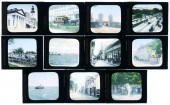 COLOR PHOTO GLASS LANTERN SLIDES
COLOR PHOTO GLASS LANTERN SLIDES (11)Eleven different scenes, 4" x 3.75" glass positive transparencies (lantern slides), mostly Florida, including George Street house, S.S. Miami at sea, Eating fruit on Hogg Island, Ostrich Farm Jacksonville, fort scene, Obispo Street, Old Vedder House, Carnival on the Prado, Old City Gate (St. Augustine), Mule-drawn streetcar, Jacksonville National Bank. All are nicely hand-tinted (?), all seem to be dated 1906 by the E.O.M. Co. Chicago and copyrighted by Alvah Roebuck, the co-founder of Sears & Roebuck, suggesting these made have been sold through the Sears catalog.
COLOR PHOTO GLASS LANTERN SLIDES
COLOR PHOTO GLASS LANTERN SLIDES (11)Eleven different scenes, 4" x 3.75" glass positive transparencies (lantern slides), mostly Florida, including George Street house, S.S. Miami at sea, Eating fruit on Hogg Island, Ostrich Farm Jacksonville, fort scene, Obispo Street, Old Vedder House, Carnival on the Prado, Old City Gate (St. Augustine), Mule-drawn streetcar, Jacksonville National Bank. All are nicely hand-tinted (?), all seem to be dated 1906 by the E.O.M. Co. Chicago and copyrighted by Alvah Roebuck, the co-founder of Sears & Roebuck, suggesting these made have been sold through the Sears catalog. -
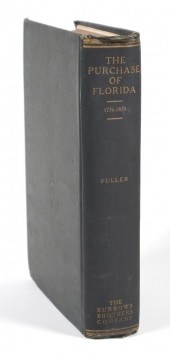 BOOK "PURCHASE OF FLORIDA", FULLER,
BOOK "PURCHASE OF FLORIDA", FULLER, 1906"The Purchase of Florida, Its History and Diplomacy" was written by Hubert Fuller, published in 1906 by Burrows Bros. Co. The first 330 pages are text, followed by 51 pages of appendices, then an index followed by some pages of current books published by the publisher of this book. There is a map following the front endpaper. The book covers early relations with Spain,Treaty of 1795, Louisiana Purchase, War of 1812, Seminole Wars, Treaty of 1819 and ending with the Florida Treaty. Very good condition, except for a few specks of foxing, and both covers loosening at the hinges. but still holding well. Pages have rough cut edges. Shelf wear top and bottom of hinge and a few marks on the black cloth covers. Shows use but not abuse. Owner's name and 1928 date stamped inside front cover.
BOOK "PURCHASE OF FLORIDA", FULLER,
BOOK "PURCHASE OF FLORIDA", FULLER, 1906"The Purchase of Florida, Its History and Diplomacy" was written by Hubert Fuller, published in 1906 by Burrows Bros. Co. The first 330 pages are text, followed by 51 pages of appendices, then an index followed by some pages of current books published by the publisher of this book. There is a map following the front endpaper. The book covers early relations with Spain,Treaty of 1795, Louisiana Purchase, War of 1812, Seminole Wars, Treaty of 1819 and ending with the Florida Treaty. Very good condition, except for a few specks of foxing, and both covers loosening at the hinges. but still holding well. Pages have rough cut edges. Shelf wear top and bottom of hinge and a few marks on the black cloth covers. Shows use but not abuse. Owner's name and 1928 date stamped inside front cover. -
 THE FIRST EVER SILVER COINS FROM
THE FIRST EVER SILVER COINS FROM THE DENVER MINTAll three first-year-issue silver coins from the Denver Mint: 1906 Barber Silver Half Dollar, Silver Quarter and Silver Dime. Deluxe Display Box. Display box measures 11-1/2" L x 2" H x 4" D
THE FIRST EVER SILVER COINS FROM
THE FIRST EVER SILVER COINS FROM THE DENVER MINTAll three first-year-issue silver coins from the Denver Mint: 1906 Barber Silver Half Dollar, Silver Quarter and Silver Dime. Deluxe Display Box. Display box measures 11-1/2" L x 2" H x 4" D -
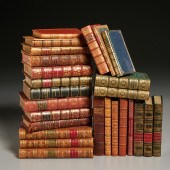 COLLECTION SMALL LEATHER-BOUND
COLLECTION SMALL LEATHER-BOUND BOOKS 19th-early 20th c., comprising approx. (26) volumes by various authors, including a three-volume set of "Tour of Dr. Syntax" with colored illustrations after Rowlandson, and a 1906 binding by Sangorski & Sutcliffe for Brentano's of "Essays Moral and Polite," John Ruskin "Sesame and Lilies," Alexander Ireland, "Book Lover's Enchyridion," cased, and others
COLLECTION SMALL LEATHER-BOUND
COLLECTION SMALL LEATHER-BOUND BOOKS 19th-early 20th c., comprising approx. (26) volumes by various authors, including a three-volume set of "Tour of Dr. Syntax" with colored illustrations after Rowlandson, and a 1906 binding by Sangorski & Sutcliffe for Brentano's of "Essays Moral and Polite," John Ruskin "Sesame and Lilies," Alexander Ireland, "Book Lover's Enchyridion," cased, and others -
 SPRINGFIELD ARMORY 1906 BAYONET &
SPRINGFIELD ARMORY 1906 BAYONET & R.I.A. SCABBARD Springfield Armory 1906 bayonet sword, marked "S A / 1906 / US / 157920" to blade, inscribed "N.Y. / E 3" to wooden handle, together with leather scabbard marked "RIA" for Rock Island Artillery and "1907 / H.E.K / CO L Sheathed: 9" 22" L x 4" W.
SPRINGFIELD ARMORY 1906 BAYONET &
SPRINGFIELD ARMORY 1906 BAYONET & R.I.A. SCABBARD Springfield Armory 1906 bayonet sword, marked "S A / 1906 / US / 157920" to blade, inscribed "N.Y. / E 3" to wooden handle, together with leather scabbard marked "RIA" for Rock Island Artillery and "1907 / H.E.K / CO L Sheathed: 9" 22" L x 4" W. -
 TWO ETCHINGS BY RENOIR AND
TWO ETCHINGS BY RENOIR AND GIACOMETTI FIRST HALF OF THE 20TH CENTURY LARGEST FRAMED 20” X 16”.TWO ETCHINGS BY RENOIR AND GIACOMETTI, First Half of the 20th Century, 1) "Femme couchee (tournee a droite) 2e Planche", 1906 by Pierre-August Renoir. Delteil 14. 5.5" x 7.75". 2) "The Search" by Alberto Giacometti. From the cancelled plate, with the Collector's Guild Ltd. label affixed to the frame verso. 10" x 7.75". Dimensions: Largest framed 20" x 16".
TWO ETCHINGS BY RENOIR AND
TWO ETCHINGS BY RENOIR AND GIACOMETTI FIRST HALF OF THE 20TH CENTURY LARGEST FRAMED 20” X 16”.TWO ETCHINGS BY RENOIR AND GIACOMETTI, First Half of the 20th Century, 1) "Femme couchee (tournee a droite) 2e Planche", 1906 by Pierre-August Renoir. Delteil 14. 5.5" x 7.75". 2) "The Search" by Alberto Giacometti. From the cancelled plate, with the Collector's Guild Ltd. label affixed to the frame verso. 10" x 7.75". Dimensions: Largest framed 20" x 16". -
 A TECO FOOTED JARDINIèRE GARDEN
A TECO FOOTED JARDINIèRE GARDEN POTA Teco footed jardinière garden pot, First-quarter 20th Century; Terra Cotta, IL Impressed: Teco Designed 1906 by William Day Gates, shape no. 157, the large art pottery jardiniere with matte green glaze raised on four flared feet 15.75" H x 22" Dia. Literature: Sharon S. Darling, "Teco: Art Pottery of the Prairie School," 1989, pp. 47 and 140, fig. 48. Dimensions: 15.75" H x 22" Dia.
A TECO FOOTED JARDINIèRE GARDEN
A TECO FOOTED JARDINIèRE GARDEN POTA Teco footed jardinière garden pot, First-quarter 20th Century; Terra Cotta, IL Impressed: Teco Designed 1906 by William Day Gates, shape no. 157, the large art pottery jardiniere with matte green glaze raised on four flared feet 15.75" H x 22" Dia. Literature: Sharon S. Darling, "Teco: Art Pottery of the Prairie School," 1989, pp. 47 and 140, fig. 48. Dimensions: 15.75" H x 22" Dia. -
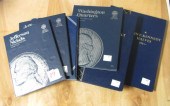 U.S. COIN COLLECTION IN SIX BLUE
U.S. COIN COLLECTION IN SIX BLUE WHITMAN COIN FOLDU.S. COIN COLLECTION IN SIX BLUE WHITMAN COIN FOLDERS: 17 Jefferson nickels in two albums; 85 Lincoln head pennies starting at 1941; 9 Washington silver quarters from the 1950's to 1964; 41 Roosevelt dimes, 19 Mercury dimes and a 1906 Barber dime together one folder; 14 Kennedy, 6 Franklin and 6 Walking Liberty half dollars in one folder.
U.S. COIN COLLECTION IN SIX BLUE
U.S. COIN COLLECTION IN SIX BLUE WHITMAN COIN FOLDU.S. COIN COLLECTION IN SIX BLUE WHITMAN COIN FOLDERS: 17 Jefferson nickels in two albums; 85 Lincoln head pennies starting at 1941; 9 Washington silver quarters from the 1950's to 1964; 41 Roosevelt dimes, 19 Mercury dimes and a 1906 Barber dime together one folder; 14 Kennedy, 6 Franklin and 6 Walking Liberty half dollars in one folder. -
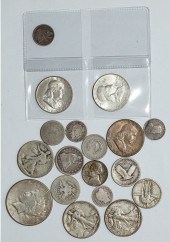 US TYPE COIN COLLECTION, MAINLY
US TYPE COIN COLLECTION, MAINLY SILVER 1944-P Nickel, 1904 Canadian Dime G, Undated Shield Nickel, 1906 V Nickel G, 1886 Seated Dime VF, 2 Barber Dimes 1892 G6 and 1914 G, 1853 A+R quarter F/VF scratched, 1906 Barber Quarter AG, 2-1926 Standing Liberty Quarters G and VF25, 3 Walking Liberty Halves (1918 AG, 1934 F, 1944 XF), 2-AU55 1949 Franklins, and 1950 XF and 1923-S Peace Dollar VG.
US TYPE COIN COLLECTION, MAINLY
US TYPE COIN COLLECTION, MAINLY SILVER 1944-P Nickel, 1904 Canadian Dime G, Undated Shield Nickel, 1906 V Nickel G, 1886 Seated Dime VF, 2 Barber Dimes 1892 G6 and 1914 G, 1853 A+R quarter F/VF scratched, 1906 Barber Quarter AG, 2-1926 Standing Liberty Quarters G and VF25, 3 Walking Liberty Halves (1918 AG, 1934 F, 1944 XF), 2-AU55 1949 Franklins, and 1950 XF and 1923-S Peace Dollar VG. -
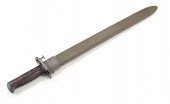 U.S. SA 1906 BAYONET WITH USN MK1
U.S. SA 1906 BAYONET WITH USN MK1 SCABBARD U.S. SA 1906 bayonet. Serial number 73016. 15-7/8" blade length, 20-1/2" overall. Together with a USN MK1 scabbard.
U.S. SA 1906 BAYONET WITH USN MK1
U.S. SA 1906 BAYONET WITH USN MK1 SCABBARD U.S. SA 1906 bayonet. Serial number 73016. 15-7/8" blade length, 20-1/2" overall. Together with a USN MK1 scabbard. -
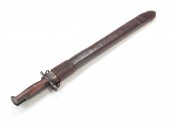 WWI U.S. SA 1906 BAYONET WITH
WWI U.S. SA 1906 BAYONET WITH LEATHER SCABBARD WWI U.S. SA 1906 bayonet. Serial number 166159. Together with a 1908 Rock Island Arsenal leather scabbard. 15-7/8" blade length, 20-1/2" overall.
WWI U.S. SA 1906 BAYONET WITH
WWI U.S. SA 1906 BAYONET WITH LEATHER SCABBARD WWI U.S. SA 1906 bayonet. Serial number 166159. Together with a 1908 Rock Island Arsenal leather scabbard. 15-7/8" blade length, 20-1/2" overall. -
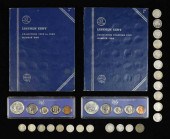 US COINS SOME SILVER8 Pre 1965
US COINS SOME SILVER8 Pre 1965 Roosevelt Dimes. 1905 and 1906 Barber Dimes. 1908 Liberty Head Nickel. 1943 D Jefferson Nickel. 11 Indian Head Nickels. 1966 and 1967 US Mint Sets. Two Lincoln Cent books partially filled.
US COINS SOME SILVER8 Pre 1965
US COINS SOME SILVER8 Pre 1965 Roosevelt Dimes. 1905 and 1906 Barber Dimes. 1908 Liberty Head Nickel. 1943 D Jefferson Nickel. 11 Indian Head Nickels. 1966 and 1967 US Mint Sets. Two Lincoln Cent books partially filled. -
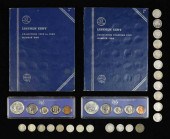 US COINS SOME SILVER8 Pre 1965
US COINS SOME SILVER8 Pre 1965 Roosevelt Dimes. 1905 and 1906 Barber Dimes. 1908 Liberty Head Nickel. 1943 D Jefferson Nickel. 11 Indian Head Nickels. 1966 and 1967 US Mint Sets. Two Lincoln Cent books partially filled.
US COINS SOME SILVER8 Pre 1965
US COINS SOME SILVER8 Pre 1965 Roosevelt Dimes. 1905 and 1906 Barber Dimes. 1908 Liberty Head Nickel. 1943 D Jefferson Nickel. 11 Indian Head Nickels. 1966 and 1967 US Mint Sets. Two Lincoln Cent books partially filled. -
 10 BARBER HALF DOLLARS1 1905 Barber
10 BARBER HALF DOLLARS1 1905 Barber Half Dollar San Francisco Mint. 1 1906 Barber Half Dollar Philadelphia Mint. 3 1906 Barber Half Dollar Denver Mint. 1 1907 Barber Half Dollar Philadelphia Mint. 1 1907 Barber Half Dollar New Orleans Mint. 1 1907 Barber Half Dollar San Francisco Mint. 2 1907 Barber Half Dollars Denver Mint.
10 BARBER HALF DOLLARS1 1905 Barber
10 BARBER HALF DOLLARS1 1905 Barber Half Dollar San Francisco Mint. 1 1906 Barber Half Dollar Philadelphia Mint. 3 1906 Barber Half Dollar Denver Mint. 1 1907 Barber Half Dollar Philadelphia Mint. 1 1907 Barber Half Dollar New Orleans Mint. 1 1907 Barber Half Dollar San Francisco Mint. 2 1907 Barber Half Dollars Denver Mint. -
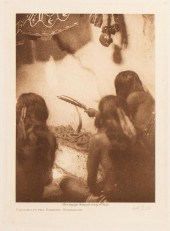 EDWARD S. CURTIS, SINGING TO THE
EDWARD S. CURTIS, SINGING TO THE SNAKES - SHIPAULOVIEdward S. Curtis, (1868 - 1952) Singing to the Snakes - Shipaulovi, intaglio photogravure, restrike edition 64 of 228 titled lower left: SINGING TO THE SNAKES - SHIPAULOVI inscribed lower center: From Copyright Photograph 1906 by E. S. Curtis editioned in graphite lower right: 64/228 intaglio photogravure, restrike edition 64 of 228 Dimensions: 7 5/16 x 5 3/8 in. (18.57 x 13.65 cm.), Frame: 15 1/4 x 13 1/8 x 1/2 in. (38.74 x 33.34 x 1.27 cm.) Provenance: Private Collection, New Mexico
EDWARD S. CURTIS, SINGING TO THE
EDWARD S. CURTIS, SINGING TO THE SNAKES - SHIPAULOVIEdward S. Curtis, (1868 - 1952) Singing to the Snakes - Shipaulovi, intaglio photogravure, restrike edition 64 of 228 titled lower left: SINGING TO THE SNAKES - SHIPAULOVI inscribed lower center: From Copyright Photograph 1906 by E. S. Curtis editioned in graphite lower right: 64/228 intaglio photogravure, restrike edition 64 of 228 Dimensions: 7 5/16 x 5 3/8 in. (18.57 x 13.65 cm.), Frame: 15 1/4 x 13 1/8 x 1/2 in. (38.74 x 33.34 x 1.27 cm.) Provenance: Private Collection, New Mexico -
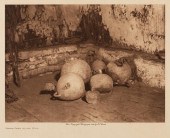 EDWARD S. CURTIS, SNAKE JARS IN THE
EDWARD S. CURTIS, SNAKE JARS IN THE KIVA, 1906Edward S. Curtis, (1868 - 1952) Snake Jars in the Kiva, 1906, photogravure on Japanese vellum titled in plate, lower left: SNAKE JARS IN THE KIVA inscribed in plate, lower center: From Copyright Photograph 1906 by E.S. Curtis photogravure on Japanese vellum Dimensions: 5 1/2 x 7 1/2 in. (14 x 19.1 cm.), Sheet: 9 1/2 x 12 1/2 in. (24.1 x 31.8 cm.) Provenance: Private Collection, New Mexico
EDWARD S. CURTIS, SNAKE JARS IN THE
EDWARD S. CURTIS, SNAKE JARS IN THE KIVA, 1906Edward S. Curtis, (1868 - 1952) Snake Jars in the Kiva, 1906, photogravure on Japanese vellum titled in plate, lower left: SNAKE JARS IN THE KIVA inscribed in plate, lower center: From Copyright Photograph 1906 by E.S. Curtis photogravure on Japanese vellum Dimensions: 5 1/2 x 7 1/2 in. (14 x 19.1 cm.), Sheet: 9 1/2 x 12 1/2 in. (24.1 x 31.8 cm.) Provenance: Private Collection, New Mexico -
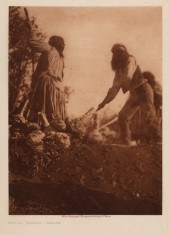 EDWARD S. CURTIS, MESCAL BAKERS -
EDWARD S. CURTIS, MESCAL BAKERS - APACHE, 1906Edward S. Curtis, (1868 - 1952) Mescal Bakers - Apache, 1906, photogravure on Japanese gampi tissue mounted to Holland Van Gelder titled in plate, lower left: MESCAL BAKERS - APACHE inscribed in plate, lower center: From Copyright Photograph 1906 by E.S. Curtis photogravure on Japanese gampi tissue mounted to Holland Van Gelder Dimensions: 7 1/4 x 5 3/8 in. (18.4 x 13.7 cm.), Sheet: 12 1/2 x 9 1/2 in. (31.8 x 24.1 cm.) Provenance: Private Collection. New Mexico
EDWARD S. CURTIS, MESCAL BAKERS -
EDWARD S. CURTIS, MESCAL BAKERS - APACHE, 1906Edward S. Curtis, (1868 - 1952) Mescal Bakers - Apache, 1906, photogravure on Japanese gampi tissue mounted to Holland Van Gelder titled in plate, lower left: MESCAL BAKERS - APACHE inscribed in plate, lower center: From Copyright Photograph 1906 by E.S. Curtis photogravure on Japanese gampi tissue mounted to Holland Van Gelder Dimensions: 7 1/4 x 5 3/8 in. (18.4 x 13.7 cm.), Sheet: 12 1/2 x 9 1/2 in. (31.8 x 24.1 cm.) Provenance: Private Collection. New Mexico
...many more examples with full details are available to our members - Learn more
